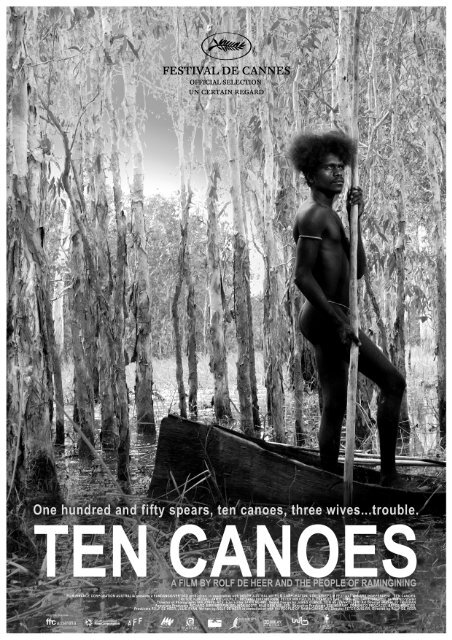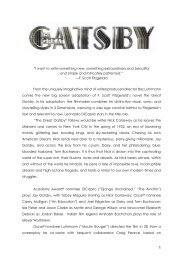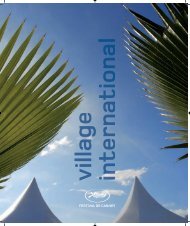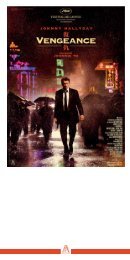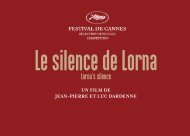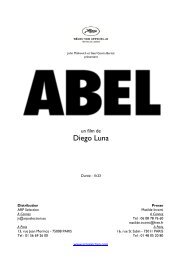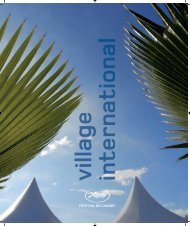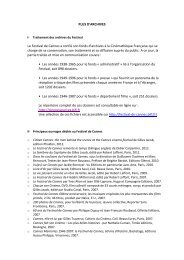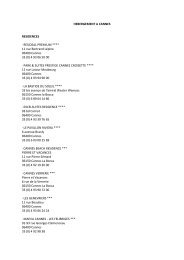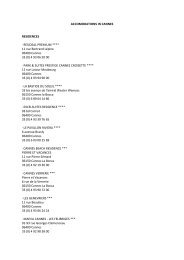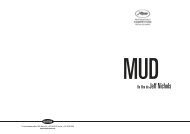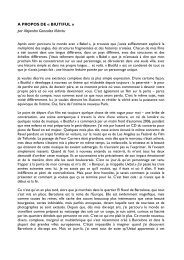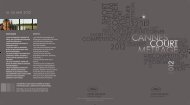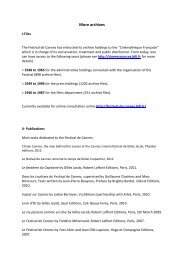in English - Cannes International Film Festival
in English - Cannes International Film Festival
in English - Cannes International Film Festival
You also want an ePaper? Increase the reach of your titles
YUMPU automatically turns print PDFs into web optimized ePapers that Google loves.
TEN CANOES<br />
INTERNATIONAL SALES<br />
wild bunch<br />
PARIS OFFICE<br />
99 Rue de la Verrerie<br />
75004 Paris - France<br />
tel +33 1 53 01 50 30<br />
fax +33 1 53 01 50 49<br />
CANNES SALES OFFICE<br />
23 rue Macé - 4th floor<br />
Corner of Croisette<br />
(above Louis Vuitton shop)<br />
tel +33 4 93 99 31 68<br />
fax +33 4 93 99 64 77<br />
CANNES MARKETING OFFICE<br />
5 square Mérimée - 1st floor<br />
tel +33 4 93 68 71 62<br />
FAX: +33 4 93 68 82 94<br />
SALES AGENTS<br />
V<strong>in</strong>cent Maraval<br />
+33 6 11 91 23 93<br />
vmaraval@exception-wb.com<br />
Gaël Nouaille<br />
+33 6 21 23 04 72<br />
gnouaille@exception-wb.com<br />
Carole Baraton<br />
+33 6 20 36 77 72<br />
cbaraton@exception-wb.com<br />
Silvia Simonutti<br />
+33 6 20 74 95 08<br />
ssimonutti@exception-wb.com<br />
www.wildbunch.biz<br />
A FILM BY ROLF DE HEER<br />
INTERNATIONAL PR<br />
THE PR CONTACT<br />
CANNES OFFICE<br />
All Suites Garden Studio,<br />
All Suites Residence,<br />
12 rue Latour Maubourg<br />
Phil Symes<br />
+33 6 09 23 86 37<br />
Ronaldo Mourao<br />
+33 6 09 28 89 55<br />
Virg<strong>in</strong>ia Garcia<br />
+33 6 18 55 93 62<br />
Crist<strong>in</strong>a Sibaldi<br />
+33 6 23 25 78 31<br />
festival@theprcontact.com<br />
philsymes@theprcontact.com<br />
ronaldo@theprcontact.com<br />
FRENCH DISTRIBUTION<br />
Memento<br />
AUSTRALIAN SALES<br />
PALACE FILMS<br />
233 Whitehorse Rd<br />
Balwyn Vic Australia 3103<br />
tel +61 (0)3 9816 1716<br />
fax +61 (0)3 9817 4921<br />
www.palacefilms.com.au
Short Synopsis<br />
It is the distant past, tribal times. Day<strong>in</strong>di (played by Jamie Gulpilil, son of the great<br />
David Gulpilil) covets one of the wives of his older brother. To teach him the proper<br />
way, he is told a story from the mythical past, a story of wrong love, kidnapp<strong>in</strong>g,<br />
sorcery, bungl<strong>in</strong>g mayhem and revenge gone wrong.<br />
In <strong>English</strong> storytell<strong>in</strong>g (by David Gulpilil) and subtitled Ganalb<strong>in</strong>gu language, this is<br />
a film unlike any you have ever seen.
Long Synopsis<br />
A thousand years ago, tribal times <strong>in</strong> the north of Australia. Ten men, led by old<br />
M<strong>in</strong>ygululu, head <strong>in</strong>to the forest to harvest barks for canoe mak<strong>in</strong>g. It is the season of<br />
goose egg gather<strong>in</strong>g.<br />
M<strong>in</strong>ygululu learns that young Day<strong>in</strong>di, on his first egg hunt<strong>in</strong>g expedition, has taken a<br />
fancy to M<strong>in</strong>ygululu's third and youngest wife. Tribal law is <strong>in</strong> danger of be<strong>in</strong>g<br />
broken: M<strong>in</strong>ygululu deals with the situation by tell<strong>in</strong>g Day<strong>in</strong>di an ancestral story, a<br />
story that will take a very long time to tell, all through the next days of canoe mak<strong>in</strong>g<br />
and swamp travell<strong>in</strong>g and goose egg gather<strong>in</strong>g. This is that story:<br />
Long ago, <strong>in</strong> mythical times, just after the great flood covered the whole land,<br />
Ridjimiraril lives with his three wives, wise Banalandju, jealous Nowal<strong>in</strong>gu and<br />
beautiful young Munandjarra, <strong>in</strong> a camp with others, <strong>in</strong>clud<strong>in</strong>g Birr<strong>in</strong>birr<strong>in</strong>, a fat man<br />
who loves honey. Some distance away, <strong>in</strong> the s<strong>in</strong>gle men's camp, lives Yeeralparil,<br />
Ridjimiraril's younger brother. Yeeralparil has no wives yet, and none promised, but<br />
is keen on that beautiful Munandjarra, who he feels should be his.<br />
One day, a Stranger approaches, without warn<strong>in</strong>g. The men are alarmed, especially<br />
when the Stranger claims he is there to trade <strong>in</strong> magic objects. He is given food and<br />
sent on his way. The sorcerer comes to warn the men of the possible dangers, but<br />
declares the camp is safe. Life goes on as normal.<br />
After a fight with Banalandju, Nowal<strong>in</strong>gu vanishes. Ridjimiraril is conv<strong>in</strong>ced his<br />
beloved second wife was taken by the Stranger, but the consensus is that be<strong>in</strong>g<br />
jealous, she simply ran away.<br />
Months later an old uncle reports hav<strong>in</strong>g seen Nowal<strong>in</strong>gu <strong>in</strong> a distant camp with the<br />
Stranger. The men are galvanised <strong>in</strong>to action: a war party sets off, but without<br />
Yeeralparil. Both brothers cannot go... if the older one is killed, the younger one must<br />
take over his wives. Yeeralparil hangs around the ma<strong>in</strong> camp <strong>in</strong> the hope of see<strong>in</strong>g<br />
Munandjarra, but Banalandju ensures a safe distance between the two.<br />
The war party returns, without Nowal<strong>in</strong>gu: the old uncle's eyes must have deceived<br />
him. Ridjimiraril, still conv<strong>in</strong>ced it was the Stranger who took Nowal<strong>in</strong>gu, slides <strong>in</strong>to<br />
depression, until Birr<strong>in</strong>birr<strong>in</strong> runs <strong>in</strong>to camp with the news that the Stranger has been<br />
seen nearby. Ridjimiraril tells Birr<strong>in</strong>birr<strong>in</strong> he's go<strong>in</strong>g to talk to the Stranger but grabs<br />
his spears and takes off, Birr<strong>in</strong>birr<strong>in</strong> puff<strong>in</strong>g beh<strong>in</strong>d.<br />
Deep <strong>in</strong> the bush they see the Stranger, squatt<strong>in</strong>g for a shit. Ridjimiraril launches a<br />
spear. An <strong>in</strong>spection of the body, however, reveals that Ridjimiraril has killed the<br />
wrong stranger. There are sounds of approach<strong>in</strong>g people. Ridjimiraril breaks the spear<br />
off and they quickly hide the body.<br />
But they do not hide it well enough. Days later Ridjimiraril and Birr<strong>in</strong>birr<strong>in</strong> are<br />
accosted by a group of warriors <strong>in</strong>clud<strong>in</strong>g the Stranger. They have identified the<br />
spearhead <strong>in</strong> the Stranger's brother's body as hav<strong>in</strong>g been made by Birr<strong>in</strong>birr<strong>in</strong>, and<br />
they want payback. Ridjimiraril confesses, and the location and time for the payback<br />
ceremony is agreed to.<br />
A sad little procession of men leaves camp for the payback. This time Yeeralparil can<br />
go, as only one person is to be speared, either Ridjimiraril or his payback partner.<br />
Yeeralparil argues that it should be he, young and nimble, who ought partner his<br />
brother. Ridjimiraril agrees, and together the two brothers face the spears from the<br />
aggrieved Stranger's tribe. That is the law, and the law must be upheld.
Ridjimiraril is speared. Justice done, he is helped back to camp. Banalandju tends his<br />
wound, but <strong>in</strong>stead of gett<strong>in</strong>g better, as he should, Ridjimiraril decl<strong>in</strong>es: it is as if a<br />
bad spirit has <strong>in</strong>vaded his body. Even the sorcerer can do noth<strong>in</strong>g. In his last moments<br />
before dy<strong>in</strong>g, Ridjimiraril staggers to his feet and beg<strong>in</strong>s to dance his own death<br />
dance...then he collapses and dies.<br />
After all the correct ceremony has been performed, Yeeralparil f<strong>in</strong>ally moves <strong>in</strong>to the<br />
ma<strong>in</strong> camp, to be with his Munandjarra. But he's <strong>in</strong>herited a great deal more than he<br />
expected...<br />
M<strong>in</strong>ygululu's story is over, the goose egg hunters return home. Day<strong>in</strong>di has learnt his<br />
lesson, and when opportunity presents, he decl<strong>in</strong>es...maybe some day he will have a<br />
wife, but it won't be someone else's.
Glossary and Explanations<br />
Yolngu: The literal translation of Yolngu is simply, "the people", but it is used<br />
nowadays as a term to describe the group of Australian Indigenous people<br />
(aborig<strong>in</strong>als) liv<strong>in</strong>g <strong>in</strong> or orig<strong>in</strong>at<strong>in</strong>g from central and eastern Arnhem Land <strong>in</strong><br />
Australia's Northern Territory.<br />
Balanda: A word mean<strong>in</strong>g "white person(s)", com<strong>in</strong>g from the word "Hollander"...the<br />
Dutch were the first white people to come <strong>in</strong>to contact with the Yolngu.<br />
Ram<strong>in</strong>g<strong>in</strong><strong>in</strong>g: A town of about 800 Yolngu people <strong>in</strong> the northern part of central<br />
Arnhem Land. The town was created <strong>in</strong> the early 1970s when the Mission of<br />
Mill<strong>in</strong>gimby became overcrowded. This meant that Yolngu from different areas were<br />
brought to live together, some quite a long distance from their traditional lands. There<br />
are fifteen or sixteen clans represented <strong>in</strong> Ram<strong>in</strong>g<strong>in</strong><strong>in</strong>g and about 8 different language<br />
groups.<br />
Arafura Swamp: A large area of freshwater wetlands just south and east of<br />
Ram<strong>in</strong>g<strong>in</strong><strong>in</strong>g. The swamp extends to 130,000 hectares dur<strong>in</strong>g the wet season, and is<br />
home to an <strong>in</strong>credible variety of bird, plant and animal life, <strong>in</strong>clud<strong>in</strong>g possibly the<br />
largest biomass of crocodiles <strong>in</strong> the world.<br />
Magpie geese or Gumang: One of the many species of birdlife on the swamp, the<br />
Gumang is a black and white native goose which was an important food source <strong>in</strong><br />
times gone by.<br />
Goose Egg Gather<strong>in</strong>g: Also known as Goose Egg Hunt<strong>in</strong>g. Expeditions by canoe of<br />
up to a week at a time used to be launched onto the swamp towards the end of the wet<br />
season, when the magpie geese had laid their eggs. Eggs were collected <strong>in</strong> numbers<br />
and the birds hunted for their meat.<br />
Ganalb<strong>in</strong>gu: The name of one of the clans local to the Arafura Swamp area.<br />
Ganalb<strong>in</strong>gu means "magpie goose people". It was hence an important clan <strong>in</strong> the life<br />
of the swamp (and <strong>in</strong> the mak<strong>in</strong>g of 'Ten Canoes').<br />
Payback, or Makaratta: A formal and ritualised form of punishment or retribution,<br />
usually with attendant ceremony. Warriors from the aggrieved tribe throw spears at<br />
the perceived culprit until blood is drawn. Sometimes the wound is fatal, sometimes<br />
only m<strong>in</strong>or. Occasionally a partner is chosen by the culprit, and both face the spears.<br />
Justice is deemed to be done when either one, the <strong>in</strong>nocent or the perceived guilty, is<br />
hit. In many areas payback has been further ref<strong>in</strong>ed to be a simple close-range<br />
spear<strong>in</strong>g of the culprit <strong>in</strong> the leg.<br />
Death Dance: When someone was at the edge of death, ceremony would start. People<br />
would gather and <strong>in</strong>itially a dance would be performed for the dy<strong>in</strong>g person, to help<br />
him beg<strong>in</strong> to make connections with his ancestors <strong>in</strong> the spirit world. Occasionally a<br />
person, still capable but know<strong>in</strong>g he was go<strong>in</strong>g to die, would perform the death dance<br />
himself. Ceremony would cont<strong>in</strong>ue on and off for up to twelve months after the<br />
person had died.
We Need Ten Canoes!...Orig<strong>in</strong> of a <strong>Film</strong><br />
The country of the Arafura Swamp area is traditional to David Gulpilil, the great<br />
<strong>in</strong>digenous performer and Australian screen icon. Towards the end of 2000, David<br />
was cast as the lead <strong>in</strong> 'The Tracker'. Upon meet<strong>in</strong>g director Rolf de Heer some<br />
months before the shoot, David <strong>in</strong>vited him to Ram<strong>in</strong>g<strong>in</strong><strong>in</strong>g, to see his traditional<br />
lands and travel the Arafura Swamp. Rolf accepted and the two of them spent the time<br />
between Christmas and New Year together, talk<strong>in</strong>g, fish<strong>in</strong>g, eat<strong>in</strong>g bush food and<br />
learn<strong>in</strong>g to understand each other. Even then David was keen on Rolf mak<strong>in</strong>g a film<br />
there with him and his people.<br />
Dur<strong>in</strong>g and after the film<strong>in</strong>g of "The Tracker", David renewed his <strong>in</strong>vitation to Rolf to<br />
make a film <strong>in</strong> Ram<strong>in</strong>g<strong>in</strong><strong>in</strong>g - maybe a Western with cowboys and cattle, or a<br />
massacre film, even "The Tracker 2". F<strong>in</strong>ally, <strong>in</strong> June 2003, David received a phone<br />
call from Rolf...could he come and talk about mak<strong>in</strong>g a film together, David to star<br />
and co-direct, all shot on the traditional lands of his people, <strong>in</strong> their language.<br />
The <strong>in</strong>itial discussions <strong>in</strong>cluded a number of David's <strong>in</strong>fluential contemporaries, such<br />
as Richard Birr<strong>in</strong>birr<strong>in</strong> and Bobby Bunungurr. But noth<strong>in</strong>g was decided. Then, on the<br />
morn<strong>in</strong>g of Rolf's departure, David came to see him. "We need ten canoes," he said.<br />
Rolf looked at him blankly. "We need ten canoes," David repeated. Suddenly Rolf<br />
understood that David meant this for the film. "David, we don't even know what the<br />
film is really about, how can we need ten canoes?". David looked at Rolf as the<br />
ignorant Balanda he was and left, re-appear<strong>in</strong>g half an hour later with a photo, black<br />
and white, taken almost seventy years before. Rolf took one look at it and said,<br />
"You're right, we need ten canoes".<br />
The photo, of a group of ten men <strong>in</strong> their bark canoes on the swamp, was profoundly<br />
c<strong>in</strong>ematic. It spoke of a world of long ago, where life was different to anyth<strong>in</strong>g that<br />
could be imag<strong>in</strong>ed by almost any Balanda anywhere.To enter that world would be the<br />
essence of real c<strong>in</strong>ema. And there were more of these photos. The film had started<br />
to form.<br />
The Donald Thomson Photographs<br />
That photo of the ten canoeists was taken by the extraord<strong>in</strong>ary photographer Dr<br />
Donald Thomson, an anthropologist who lived and worked <strong>in</strong> Arnhem Land <strong>in</strong> the<br />
mid-1930s, when life for the orig<strong>in</strong>al <strong>in</strong>habitants was still culturally little <strong>in</strong>fluenced<br />
by the com<strong>in</strong>g of white people...there had been wars aga<strong>in</strong>st the Yolngu people of<br />
Arnhem Land, and massacres, but they had never been conquered and had thus<br />
reta<strong>in</strong>ed, <strong>in</strong> very large measure, their traditional lifestyle.<br />
Thomson left a legacy of immense importance: a portrait of a people and a way of life<br />
that would otherwise have been lost. The Thomson Collection of some four thousand<br />
black and white glass plate photographs of so many aspects of Yolngu culture is held<br />
<strong>in</strong> Museum Victoria (there are another seven thousand photographs taken <strong>in</strong> Central<br />
Australia and on Cape York).<br />
Some of these photos have made their way back to Ram<strong>in</strong>g<strong>in</strong><strong>in</strong>g, and become part of<br />
the culture. There's such a concept as "Thomson Time", fondly remembered. The web<br />
of k<strong>in</strong>ship is complex: everyone is related to someone <strong>in</strong> the photographs, and<br />
everyone takes pride <strong>in</strong> them. They are their cont<strong>in</strong>uity, their history.
Life Then, Life Now<br />
Life for the pre-contact Yolngu had its hard times, but they had adapted very<br />
successfully to their environment. Their ceremonial and spiritual life was extremely<br />
rich and complex, due <strong>in</strong> part to the abundance of the food supply, which allowed<br />
them time to develop ritual and ceremony.<br />
They were semi-nomadic hunter-gatherers, mov<strong>in</strong>g seasonally with<strong>in</strong> well-def<strong>in</strong>ed<br />
boundaries depend<strong>in</strong>g on the availability of food. They had a very complex k<strong>in</strong>ship<br />
system, which determ<strong>in</strong>ed extremely strict marriage rules; a highly developed system<br />
of law; and an extensive trad<strong>in</strong>g network with other tribes great distances away.<br />
Western culture, ma<strong>in</strong>ly <strong>in</strong> the form of cattlemen, didn't really arrive until the 1880s,<br />
and was strenuously resisted. Many Yolngu were massacred, but they cont<strong>in</strong>ued to<br />
hold out aga<strong>in</strong>st white <strong>in</strong>cursion. It was not until Thomson <strong>in</strong> the 1930s that peace,<br />
and ultimately a conversion to a mixture of white and Yolngu ways, came.<br />
Nowadays life is very different for the people of Ram<strong>in</strong>g<strong>in</strong><strong>in</strong>g. There is a supermarket<br />
and a takeaway shop. People live <strong>in</strong> houses with plumb<strong>in</strong>g and television, and do their<br />
bank<strong>in</strong>g over the <strong>in</strong>ternet. Some of the old ways rema<strong>in</strong>: the k<strong>in</strong>ship system, though<br />
modified, is still strong; some of the ceremonial life is as important as it was a century<br />
ago; people still hunt and fish, though 4-wheel drives, guns and fish<strong>in</strong>g l<strong>in</strong>es are<br />
<strong>in</strong>creas<strong>in</strong>gly the tools of choice. Conventional work is scarce and <strong>in</strong>creas<strong>in</strong>gly<br />
there is engagement with the arts and craft, which <strong>in</strong> turn helps keep some of the<br />
traditions alive.<br />
A Story to Please Two Cultures<br />
The story and script were created with the community. The Yolngu storytell<strong>in</strong>g<br />
tradition is strong but its conventions very different to those of the West. It became<br />
clear that the challenge was to make a film that would satisfy both local tastes and<br />
requirements, and a Western c<strong>in</strong>ema audience. Over the next year and a half, Rolf<br />
visited Ram<strong>in</strong>g<strong>in</strong><strong>in</strong>g on numerous occasions. Each time, more of the Yolngu would<br />
get to know him, and the circle of consultation became wider. This was crucial.<br />
There were several storytell<strong>in</strong>g problems to overcome. The first was the desire of the<br />
locals to have goose egg gather<strong>in</strong>g (the ten canoes photo was taken dur<strong>in</strong>g such an<br />
expedition) central to the film. The problem: goose egg gather<strong>in</strong>g itself is particularly<br />
non-dramatic <strong>in</strong> the paradigm of Western c<strong>in</strong>ema.<br />
Secondly, the old times were precious to the community; the Yolngu collaborators did<br />
not want to depict them as times of conflict. And conflict was essential if the film was<br />
to work for a Western audience.<br />
And the third major problem was that the Thomson photos were <strong>in</strong> black and<br />
white...the cultural history of the people was <strong>in</strong> black and white, but the film was<br />
contractually bound to be a colour film.<br />
These problems were solved by sett<strong>in</strong>g the ma<strong>in</strong> dramatic part of the story <strong>in</strong> mythical<br />
times, when for the Yolngu anyth<strong>in</strong>g was allowed to happen, and shoot<strong>in</strong>g it <strong>in</strong><br />
colour...that dramatic story could then be told as a cautionary tale dur<strong>in</strong>g a hunt<strong>in</strong>g<br />
expedition, which would be shot <strong>in</strong> black and white. A script which pleased both<br />
cultures was then possible.
Language...the Cosmological Divide<br />
Ram<strong>in</strong>g<strong>in</strong><strong>in</strong>g is a place of many languages. People speak to whoever <strong>in</strong> their own clan<br />
language, which is well understood by most others, who then tend to reply <strong>in</strong> their<br />
own particular language. In the film, for example, several of the canoeists are<br />
Ganalb<strong>in</strong>gu speakers, but M<strong>in</strong>ygululu speaks Mandalp<strong>in</strong>gu, David Gulpilil's<br />
language. Crusoe Kurddal, who plays Ridjimiraril, speaks another language still, one<br />
from Man<strong>in</strong>grida. But <strong>in</strong> general, each understands the other perfectly well.<br />
For many of the Yolngu residents though, <strong>English</strong> is perhaps their fifth or sixth<br />
language...spoken rudimentarily if at all. They understand a little more than they can<br />
speak, but it becomes very difficult to know how much. And there is an immense<br />
difference between the Yolngu languages (how they are spoken and structured, their<br />
tenses and syntax, the very cosmology they describe), and <strong>English</strong>.<br />
It was fortunate that several of the cast, notably Peter Djigirr, Richard Birr<strong>in</strong>birr<strong>in</strong> and<br />
Frances Djulib<strong>in</strong>g, were good <strong>English</strong> speakers. They and others would work through<br />
the communication problems between actors and director until everyone seemed to<br />
know what to do and what to say.<br />
Who Does the Cast<strong>in</strong>g?<br />
There were a number of stages to the cast<strong>in</strong>g, each more unconventional than<br />
the next.<br />
Dur<strong>in</strong>g the construction of the story, the participants had clear claims to be<strong>in</strong>g <strong>in</strong><br />
the film and assumed they would be <strong>in</strong> it, but weren't always obvious cast<strong>in</strong>g.<br />
Birr<strong>in</strong>birr<strong>in</strong>, for example, was overweight, <strong>in</strong> a way that no Yolngu would have been.<br />
And so a role had to be created especially for him.<br />
Then there were the canoeists. The ten men <strong>in</strong> Thomson's photo have, over the years,<br />
been <strong>in</strong>dividually identified, and many <strong>in</strong> Ram<strong>in</strong>g<strong>in</strong><strong>in</strong>g are related to at least one of<br />
them. Those with the strongest claims chose themselves to play their ancestor, as they<br />
saw it, and that was the end of that.<br />
The third stage was the most complex. If the characters had a certa<strong>in</strong> k<strong>in</strong> relationship<br />
(for example man and wife), then the actors play<strong>in</strong>g those characters had to be able to<br />
have the same relationship. Every Yolngu is classified as either Yirritja or Dhua. A<br />
Yirritja man cannot marry a Yirritja woman, and hence half the women <strong>in</strong><br />
Ram<strong>in</strong>g<strong>in</strong><strong>in</strong>g, be<strong>in</strong>g Yirritja, were excluded from consideration for that role. And<br />
there are a number of subsections...if you're of the wrong Dhua subsection, then you<br />
can't be seen on screen married to a Yirritja man either.... And if a character has a<br />
relationship with two other characters, then both relationships have to conform to the<br />
k<strong>in</strong>ship system. From an already small pool of available actors, there was sometimes<br />
only one person who was possible for a particular role.
The First Swamp Canoe<br />
As the shoot drew nearer, it became time for the Yolngu to beg<strong>in</strong> mak<strong>in</strong>g all the<br />
artefacts needed for the production: spears and stone axes; dilly bags and canoes; arm<br />
bands and shelters. As <strong>in</strong> old times, the work was divided very dist<strong>in</strong>ctly along gender<br />
l<strong>in</strong>es...the men made the canoes and the weapons, the women the huts, bags and body<br />
decorations. There was the feel<strong>in</strong>g of do<strong>in</strong>g someth<strong>in</strong>g special, of cultural renewal, of<br />
br<strong>in</strong>g<strong>in</strong>g back the old times.<br />
The canoes were a particular example. Those of the Arafura Swamp were designed to<br />
function <strong>in</strong> the precise environmental conditions of the swamp. There were no other<br />
canoes like them anywhere <strong>in</strong> Australia, but none had been built here for decades. The<br />
expertise, however, still existed among the older men, <strong>in</strong> particular M<strong>in</strong>ygululu and<br />
Pussycat.<br />
Appropriate trees were selected and a sheet of bark up to four metres long and a<br />
metre wide was cut and pried off each tree <strong>in</strong> a s<strong>in</strong>gle piece. The barks were soaked<br />
overnight, then heated through and softened on a fire, bent <strong>in</strong>to shape and sewn us<strong>in</strong>g<br />
natural 'str<strong>in</strong>g' gathered from certa<strong>in</strong> shrubs.<br />
There was gather<strong>in</strong>g excitement, more so among the younger men who had never<br />
seen this before, as the canoe took shape. By the end of the day, it had been<br />
completed. This one canoe was a small miracle, even for the Yolngu...forgotten<br />
aspects of their culture were be<strong>in</strong>g brought back from the br<strong>in</strong>k ext<strong>in</strong>ction, and they<br />
knew it.<br />
The Camp<br />
Meanwhile the production crew arrived and began to transform Murwangi, an old<br />
cattle station at the edge of the swamp which was to serve as the base for film<strong>in</strong>g, <strong>in</strong>to<br />
someth<strong>in</strong>g at least notionally habitable. Tent city sprang up among the scatter<strong>in</strong>g of<br />
rusty sheds. The camp was a liv<strong>in</strong>g, vibrant, noisy entity. The cast generally brought<br />
wives, husbands and families and friends, and it was not long before more tents had to<br />
be shipped <strong>in</strong>. Children played around the camp and roamed the surround<strong>in</strong>g areas,<br />
those not work<strong>in</strong>g would go fish<strong>in</strong>g or hunt<strong>in</strong>g.<br />
There was a real benefit to this cheek-by-jowl liv<strong>in</strong>g, and that was on set. The Yolngu<br />
and the Balanda, by their enforced closeness and <strong>in</strong>term<strong>in</strong>gl<strong>in</strong>g dur<strong>in</strong>g time away<br />
from shoot<strong>in</strong>g, were very quickly and substantially demystified to each other, both<br />
personally and culturally. This led to a very easy and trust<strong>in</strong>g atmosphere on set,<br />
which was generally much calmer and quieter than camp. With the <strong>in</strong>creased<br />
understand<strong>in</strong>g of both cultures, people were able to really enjoy work<strong>in</strong>g together<br />
on set.<br />
Crocodiles, Leeches and Mosquitoes<br />
The shoot itself was divided <strong>in</strong>to dist<strong>in</strong>ct halves. First would be the black and white<br />
canoe mak<strong>in</strong>g and goose egg gather<strong>in</strong>g material, based on and at the edges of the<br />
swamp, then would come the colour material from the mythical times, to be shot<br />
mostly at the camp the Yolngu women had built and also <strong>in</strong> the forests and surrounds.<br />
The swamp shoot was a long, hard haul for Yolngu actor and Balanda crew alike.<br />
None of the cast had acted <strong>in</strong> a film before. They had not only to relearn old<br />
traditional skills, but also learn the new skills associated with screen act<strong>in</strong>g. There<br />
was also a sense of responsibility for these foolhardy Balanda, who obviously weren't
aware of the dangers - why else would they stand waist-deep <strong>in</strong> the crocodile-<strong>in</strong>fested<br />
swamp all day?<br />
First screen<strong>in</strong>g of rushes was both riotous and awesome. Every Yolngu <strong>in</strong> camp<br />
crammed <strong>in</strong>to the edit<strong>in</strong>g hut and laughed at the antics of the cast, and at what they<br />
said. But whenever a shot appeared that reflected the Thomson photographs, there<br />
were gasps and mutter<strong>in</strong>gs of recognition, that those on screen, and those contribut<strong>in</strong>g<br />
<strong>in</strong> other ways to the film, were, almost magically, rebuild<strong>in</strong>g their history.<br />
Eventually the black and white section was completed, and everyone moved to dry<br />
land. The pace of film<strong>in</strong>g picked up to such a degree that the shoot f<strong>in</strong>ished early.<br />
Mixed with the satisfaction of hav<strong>in</strong>g achieved what had seemed impossible, with the<br />
happ<strong>in</strong>ess for both Yolngu and Balanda of be<strong>in</strong>g able to return to some sort of<br />
normality, there were t<strong>in</strong>ges of regret all round that this great, glorious and difficult<br />
adventure was over, and that the like of it would probably never aga<strong>in</strong> be experienced<br />
by anyone, ever, anywhere.<br />
How the <strong>Film</strong> Has Been Received by the Community<br />
There are three versions of the film so far: one with Yolngu languages dialogue and<br />
<strong>English</strong> subtitles and storytell<strong>in</strong>g by David Gulpilil; one with both Yolngu languages<br />
dialogue and storytell<strong>in</strong>g <strong>in</strong> Mandalp<strong>in</strong>gu by David, with <strong>English</strong> subtitles; and the<br />
Yolngu version, no subtitles, everyth<strong>in</strong>g <strong>in</strong> the languages of the people whose film it<br />
is.<br />
It was this last version that played open air <strong>in</strong> Ram<strong>in</strong>g<strong>in</strong><strong>in</strong>g one steamy wet season<br />
night, as soon as it was ready, before any public screen<strong>in</strong>g. A projector and screen<br />
were flown <strong>in</strong> and people began gather<strong>in</strong>g, hours before the screen<strong>in</strong>g. By the time it<br />
was dark, there was not a soul <strong>in</strong> the streets and houses of Ram<strong>in</strong>g<strong>in</strong><strong>in</strong>g...it would<br />
have taken four basketball courts to hold everyone.<br />
The film brought laughter, pride and joy to an entire community, even those<br />
who'd had their doubts about it be<strong>in</strong>g made. For days it was a dom<strong>in</strong>ant topic of<br />
conversation. Old ways and new ways were questioned. Culture was discussed, and<br />
history, and what it means to be Yolngu. And people who had contributed to it, were<br />
changed... they had a confidence <strong>in</strong> their place <strong>in</strong> the world not seen before.<br />
What the <strong>Film</strong> Means...Djigirr Speaks<br />
We come from this land. People, Balanda, always come, m<strong>in</strong>ers and that, and we<br />
always say no to them, no m<strong>in</strong><strong>in</strong>g, because we don't want to lose our culture. White<br />
man's ways will just destroy us.<br />
We have our law from long time ago, important law for everyth<strong>in</strong>g, but all them white<br />
men come more and more and we can't stay <strong>in</strong> that law. That law just dropp<strong>in</strong>g away.<br />
If we go more further with los<strong>in</strong>g our law then maybe white men can tell us, "Where's<br />
your culture?...Noth<strong>in</strong>g, you're lost, all bad luck for you."<br />
But you film mob came here to lift up this law for us, to show how they used to sit a<br />
long time ago, them laws. So white men can see, we can see, anyone can see, we got<br />
that law.<br />
If we can't do this movie, all them Balanda put us down, but you people just come to<br />
lift us up, to teach them, because we don't want to lose our culture, you know. We<br />
gonna try and lift up that law for us with this movie, so they can recognise, "Ah, these<br />
people still got that law for them, culture, all that." It's really important this movie get
done from the start to the end. We gonna show this film, and then they can recognise,<br />
all them white mens...that's nicer.<br />
What the <strong>Film</strong> Means...Djulib<strong>in</strong>g Speaks<br />
When I first came here for the film I thought, I'm not gonna do this, I'm not gonna do<br />
that. But they took me out to the mosquito huts our women built for the film. I felt<br />
free then, I could feel the old people was with me, I could feel them. Now I'm gett<strong>in</strong>g<br />
brave and I'm gonna do whatever I have to do, whatever the director tells me to do.<br />
I'm very proud of myself...it's good to be play<strong>in</strong>g a traditional woman, the way I look<br />
for the film.<br />
It is my dest<strong>in</strong>y to do this, so all over the world they can see how my ancient<br />
ancestors had been like this before. Beh<strong>in</strong>d the black and white photos is the big story,<br />
and the kids of Ram<strong>in</strong>g<strong>in</strong><strong>in</strong>g have never heard that story...they just laugh at the funny<br />
photos, which is no respect. If they make fun of me I'll crack their heads together.<br />
This film is for the kids' future, so when they grow up they're gonna see, because not<br />
enough of the older people is try<strong>in</strong>g to teach the younger kids. It's very important<br />
what we're gonna do here with the act<strong>in</strong>g so everybody can see and understand how<br />
people was first like this. This is not just only for me...I'm do<strong>in</strong>g this for my grandkids<br />
and for the next one generation to generation. They can learn what's <strong>in</strong> this film, this<br />
movie is gonna rem<strong>in</strong>d them about our ancient ancestors.<br />
Everyth<strong>in</strong>g is chang<strong>in</strong>g, everyth<strong>in</strong>g is go<strong>in</strong>g go<strong>in</strong>g gone now. The only th<strong>in</strong>g they<br />
know is some ceremony...they not even normal kids anymore. Maybe they gonna<br />
keep this film with them so they can put it <strong>in</strong> their head.<br />
What the <strong>Film</strong> Means...Gulpilil Speaks<br />
I got tears fall<strong>in</strong>g down, I been cry<strong>in</strong>g see<strong>in</strong>g that movie, it's such a good movie. I'm<br />
proud of my people who are <strong>in</strong> that film, act<strong>in</strong>g is beautiful, just perfect, everyth<strong>in</strong>g,<br />
everybody is just great. It will hold them <strong>in</strong> the heart, the people who will see it, it'll<br />
take you way down to the wilderness.<br />
I showed a photograph from Donald Doctor Thomson to Rolf de Heer and said what<br />
do you th<strong>in</strong>k? Rolf de Heer started to write that story with Ram<strong>in</strong>g<strong>in</strong><strong>in</strong>g people, my<br />
people, and we started to work together.<br />
I had to talk to Gudthaykudthay and M<strong>in</strong>ygululu and Bunungurr and Bunyira and<br />
Djigirr and Birr<strong>in</strong>birr<strong>in</strong> and I said okay, we'll make that canoes. I wasn't even there<br />
but they started to work on the canoes and it's really hard work but it was really<br />
perfectly done.<br />
I thought it wasn't gonna work but you know it was a thousand millions of mosquitoes<br />
and leeches and you name it but I tell you what, lucky it was Rolf de Heer, if Rolf de<br />
Heer wasn't there it wouldn't have been happen<strong>in</strong>g this story, this story of my people.<br />
All I did when they showed me the film and the film started, I start to cry...I<br />
remember those days, I remember...and now I can see it <strong>in</strong> the film. I saw it. I really<br />
want to thanks to Rolf, what he done for my people and my people's story and a true<br />
Australian story, fair d<strong>in</strong>kum. That story is never f<strong>in</strong>ished that Ten Canoes story, it<br />
goes on forever because it is a true story of our people, it is the heart of the land and<br />
people and nature.
The Cast<br />
CRUSOE KURRDAL (Ridjimiraril)<br />
Crusoe Kurddal is the son of Crusoe Kun<strong>in</strong>gbal and Lena Kur<strong>in</strong>iya, and the brother of<br />
Timothy Wulanjbirr and Owen Yalandja. Known for his large mimih sculptures,<br />
rem<strong>in</strong>iscent of those made by his father, he started mak<strong>in</strong>g them follow<strong>in</strong>g his father’s<br />
death <strong>in</strong> 1984. He is also an accomplished dancer and has performed throughout<br />
Australia and overseas. TEN CANOES is his first act<strong>in</strong>g role.<br />
JAMIE GULPILIL (Day<strong>in</strong>di/Yeeralparil)<br />
Twenty-two-year-old Jamie Gulpilil, is the son of the great actor, David Gulpilil. His<br />
<strong>in</strong>terest <strong>in</strong> act<strong>in</strong>g began when accompany<strong>in</strong>g his father to various film shoots and film<br />
premieres. He was born and cont<strong>in</strong>ues to live <strong>in</strong> Ram<strong>in</strong>g<strong>in</strong><strong>in</strong>g. TEN CANOES is his<br />
first act<strong>in</strong>g role.<br />
RICHARD BIRRINBIRRIN (Birr<strong>in</strong>birr<strong>in</strong> & Associate Producer)<br />
Born <strong>in</strong> 1953 at Mil<strong>in</strong>gimbi Mission, Birr<strong>in</strong>birr<strong>in</strong> was <strong>in</strong>itiated on the beach outside<br />
his father's (David Malangi) self-built home. Malangi was keen that his children<br />
received balanda and yolngu education and Birr<strong>in</strong>birr<strong>in</strong> was a mental health worker<br />
for the Ram<strong>in</strong>g<strong>in</strong><strong>in</strong>g Cl<strong>in</strong>ic for 10 years. He made his perform<strong>in</strong>g debut <strong>in</strong> New York<br />
<strong>in</strong> 2002. Birr<strong>in</strong>birr<strong>in</strong> has travelled to Taipei, Tokyo and Canberra to make public art.<br />
A keen supporter of TEN CANOES dur<strong>in</strong>g its development phase, Birr<strong>in</strong>birr<strong>in</strong>’s<br />
enthusiasm and assistance provided important <strong>in</strong>troductions for the filmmakers to the<br />
Ram<strong>in</strong>g<strong>in</strong><strong>in</strong>g community. He is currently (2005) a recipient of an Australia Council<br />
grant for New Work. Treasurer of the Aborig<strong>in</strong>al artists' co-operative, Bula'bula Arts,<br />
<strong>in</strong> Ram<strong>in</strong>g<strong>in</strong><strong>in</strong>g, he is also an executive member of ANKAAA (a peak Indigenous<br />
Arts advocacy organisation).<br />
PETER MINYGULULU (M<strong>in</strong>ygululu)<br />
Peter M<strong>in</strong>ygululu, an exhibit<strong>in</strong>g artist and ceremonial leader, was born near<br />
Mirrngatja around 1942. Dur<strong>in</strong>g the development of TEN CANOES, M<strong>in</strong>ygululu was<br />
consistently supportive of the project. He is not only an authority on mak<strong>in</strong>g<br />
traditional artefacts such as bark canoes, he also remembers the time when pol<strong>in</strong>g<br />
across the Swamp to collect the magpie geese was an annual event.<br />
FRANCES DJULIBING (Nowal<strong>in</strong>gu)<br />
When Rolf de Heer was cast<strong>in</strong>g <strong>in</strong> Ram<strong>in</strong>g<strong>in</strong><strong>in</strong>g, he kept meet<strong>in</strong>g the vibrant and<br />
vivacious Frances Djulib<strong>in</strong>g, who worked at the local shop. He quickly believed she<br />
would be perfect for the role of Nowal<strong>in</strong>gu. Her enthusiasm was second to none. She<br />
had always wanted to act <strong>in</strong> a film but never thought it was possible given she lived <strong>in</strong><br />
such a remote area of Australia.
PHILIP GUDTHAYKUDTHAY (The Sorcerer)<br />
Born <strong>in</strong> 1935, Philip Gudthaykudthay is the most senior artist from Ram<strong>in</strong>g<strong>in</strong><strong>in</strong>g.<br />
Taught by great artists such as his father Dawidi and his uncle Djawa, he has been<br />
pa<strong>in</strong>t<strong>in</strong>g s<strong>in</strong>ce the 1960s. A stealthy old man with a languid gait, Pussycat, as he is<br />
known, is a senior ritual leader. His nickname comes from one of his pr<strong>in</strong>cipal totems,<br />
Burruwara, the native cat.<br />
Gudthaykudthay first sold his pa<strong>in</strong>t<strong>in</strong>gs <strong>in</strong> the 1960s. He was liv<strong>in</strong>g on the ma<strong>in</strong>land<br />
at Nangalala and work<strong>in</strong>g as a fencer, stockman and crocodile hunter. The first<br />
Ram<strong>in</strong>g<strong>in</strong><strong>in</strong>g artist to have a solo show <strong>in</strong> 1983 - it was a sell-out - he has participated<br />
<strong>in</strong> numerous national and <strong>in</strong>ternational exhibitions, <strong>in</strong>clud<strong>in</strong>g four more solo shows.<br />
DAVID GULPILIL (The Storyteller)<br />
David Gulpilil was born <strong>in</strong> 1953, <strong>in</strong> Arnhem Land <strong>in</strong> the Northern Territory of<br />
Australia. He grew up tribally near Kakadu National Park. In 1969 Nicholas Roeg<br />
cast David as the lead <strong>in</strong> WALKABOUT filmed on location <strong>in</strong> Northern Australia.<br />
Subsequent credits <strong>in</strong>clude MAD DOG MORGAN (Philippe Mora); THE LAST<br />
WAVE (Peter Weir); STORM BOY (Henri Safran); THE RIGHT STUFF (Philip<br />
Kaufman); DARK AGE (Arch Nicholson); DEAD HEART (Nick Parsons);<br />
SERENADES (Mojgan Khadem); and Wim Wender's UNTIL THE END OF THE<br />
WORLD. Gulpilil also appeared <strong>in</strong> CROCODILE DUNDEE, choreograph<strong>in</strong>g the<br />
Aborig<strong>in</strong>al dance sequences, and starred <strong>in</strong> RABBIT PROOF FENCE (Phillip<br />
Noyce).<br />
One of Australia's most accomplished exponents of traditional Aborig<strong>in</strong>al dance and<br />
the didgeridoo, he has toured widely with his troupe <strong>in</strong> Australia, the US, Great<br />
Brita<strong>in</strong>, France and Japan. In 1987 he was awarded the Australia Medal, one of the<br />
highest awards to Australian citizens, for services to the Arts.<br />
TEN CANOES is his second feature with Rolf de Heer. In 2002, Gulpilil received<br />
numerous act<strong>in</strong>g awards for his role <strong>in</strong> THE TRACKER, notably w<strong>in</strong>n<strong>in</strong>g Lead Actor<br />
at the AFI Awards, IF Awards and the <strong>Film</strong> Critics Circle Awards. He also won Best<br />
Actor at the Tudawali Awards.
The Crew<br />
ROLF DE HEER (Writer/Director/Producer)<br />
De Heer's first film, TAIL OF A TIGER (1984), attracted critical and commercial<br />
success and played at the Berl<strong>in</strong> K<strong>in</strong>derfest. INCIDENT AT RAVEN'S GATE (1987)<br />
was a science fiction mystery thriller, followed by DINGO (1990) a musical odyssey<br />
starr<strong>in</strong>g jazz legend Miles Davis <strong>in</strong> his only film role.<br />
BAD BOY BUBBY (1993), de Heer's first collaboration with producer Domenico<br />
Procacci, won the Grand Special Jury Prize and <strong>International</strong> <strong>Film</strong> Critics Prize at the<br />
1993 Venice <strong>Film</strong> <strong>Festival</strong>, as well as four Australian <strong>Film</strong> Institute Awards. He spent<br />
the next two years work<strong>in</strong>g on EPSILON (1995), and THE QUIET ROOM. The story<br />
of a family breakdown as seen through the eyes of a child, THE QUIET ROOM was<br />
screened <strong>in</strong> Official Competition <strong>in</strong> the 1996 <strong>Cannes</strong> <strong>International</strong> <strong>Film</strong> <strong>Festival</strong>.<br />
In 1997 de Heer directed DANCE ME TO MY SONG, selected for Official<br />
Competition at the 1998 <strong>Cannes</strong> <strong>Film</strong> <strong>Festival</strong>. In 1999, he spent three months <strong>in</strong> the<br />
jungles of French Guyana shoot<strong>in</strong>g THE OLD MAN WHO READ LOVE STORIES.<br />
De Heer's next film, THE TRACKER debuted to stand<strong>in</strong>g ovations at the 2002<br />
Adelaide <strong>Festival</strong> of Arts and was <strong>in</strong> Official Competition at the 2002 Venice<br />
<strong>International</strong> <strong>Film</strong> <strong>Festival</strong>. The film won, among others, the Special Jury Prize at the<br />
2002 Valladolid <strong>International</strong> <strong>Film</strong> <strong>Festival</strong>, Best <strong>Film</strong> at both the 2002 Circle of <strong>Film</strong><br />
Critics Awards and the 2002 IF (people's) Awards.<br />
ALEXANDRA'S PROJECT debuted <strong>in</strong> Official Competition at the Berl<strong>in</strong><br />
<strong>International</strong> <strong>Film</strong> <strong>Festival</strong> <strong>in</strong> 2003 and went on to screen at numerous <strong>in</strong>ternational<br />
festivals <strong>in</strong>clud<strong>in</strong>g Puchon, Ed<strong>in</strong>burgh, Telluride, Toronto and Montreal. TEN<br />
CANOES is de Heer's eleventh feature.<br />
PETER DJIGIRR (Co-director & Canoeist)<br />
Djigirr is a key member of the Arafura Swamp people. He was born <strong>in</strong> 1963 <strong>in</strong> the<br />
country around Djilp<strong>in</strong> Gorge. He is known as the “crocodile man” and is regarded as<br />
the local expert on catch<strong>in</strong>g crocodiles and locat<strong>in</strong>g their eggs for harvest on the<br />
Swamp each year.<br />
Djigirr’s assistance as co-director was vital dur<strong>in</strong>g the shoot. He was <strong>in</strong>volved<br />
extensively <strong>in</strong> cast<strong>in</strong>g, locations and logistics, and was a key liaison between the<br />
Yolgnu community and balanda crew.
JULIE RYAN (Producer)<br />
After briefly work<strong>in</strong>g as an assistant <strong>in</strong> a film publicity company, Julie Ryan entered<br />
the Australian film <strong>in</strong>dustry <strong>in</strong> 1996 when she worked as production secretary with<br />
Rolf de Heer on THE SOUND OF ONE HAND CLAPPING. She jo<strong>in</strong>ed Vertigo<br />
Productions as production manager on de Heer's feature film DANCE ME TO MY<br />
SONG, which was selected for <strong>Cannes</strong> <strong>in</strong> 1998. She then produced the award<br />
w<strong>in</strong>n<strong>in</strong>g SBS documentary, HEATHER ROSE GOES TO CANNES. In 1999, Ryan<br />
spent three months <strong>in</strong> the jungles of French Guyana co-produc<strong>in</strong>g her first feature<br />
film, THE OLD MAN WHO READ LOVE STORIES, starr<strong>in</strong>g Richard Dreyfuss and<br />
Hugo Weav<strong>in</strong>g. Ryan's next feature with de Heer, THE TRACKER, was selected for<br />
the Venice <strong>International</strong> <strong>Film</strong> <strong>Festival</strong> <strong>in</strong> 2002. ALEXANDRA'S PROJECT, her third<br />
consecutive feature as producer with de Heer, was selected for official competition at<br />
the Berl<strong>in</strong> <strong>Film</strong> <strong>Festival</strong>.<br />
IAN JONES, ACS (Director of Photography)<br />
Ian Jones has worked extensively <strong>in</strong> Australia and <strong>in</strong>ternationally. In 2000, Jones<br />
worked as 2nd unit director / Director of Photography on RABBIT PROOF FENCE<br />
with director Phillip Noyce. Jones has also worked with Noyce on CLEAR AND<br />
PRESENT DANGER as well as operat<strong>in</strong>g on such notable feature films as THE<br />
RUSSIA HOUSE for Fred Schepsi, BORN ON THE FOURTH OF JULY for Oliver<br />
Stone and Baz Luhrman's STRICTLY BALLROOM. TEN CANOES is Jones's fifth<br />
feature film with Rolf de Heer hav<strong>in</strong>g worked with him on both DINGO (1990) and<br />
BAD BOY BUBBY (1993) and THE TRACKER and ALEXANDRA’S PROJECT.<br />
TANIA NEHME (<strong>Film</strong> Editor)<br />
An editor s<strong>in</strong>ce 1986, Tania Nehme edited numerous documentaries, commercials<br />
and short dramas before she cut her first feature, EPSILON, for Rolf de Heer <strong>in</strong><br />
1995. A graduate of the Australian <strong>Film</strong> Television & Radio School Nehme TEN<br />
CANOES is her seventh film with de Heer hav<strong>in</strong>g cut DANCE ME TO MY SONG,<br />
THE QUIET ROOM, THE TRACKER, ALEXANDRA'S PROJECTand THE OLD MAN<br />
WHO READ LOVE STORIES.<br />
JAMES CURRIE (Sound Designer)<br />
James Currie has worked <strong>in</strong> the film <strong>in</strong>dustry for nearly three decades as location<br />
recordist, sound editor, mixer and sound designer. He has worked on seven films<br />
with Rolf de Heer <strong>in</strong>clud<strong>in</strong>g TEN CANOES, ALEXANDRA'S PROJECT, THE<br />
TRACKER, THE OLD MAN WHO READ LOVE STORIES, BAD BOY BUBBY,<br />
INCIDENT AT RAVENS GATE and DINGO. Sound designer on 26 productions, he<br />
has also worked extensively with filmmaker Paul Cox on films such as LUST AND<br />
REVENGE, FATHER DAMIEN, the recently released THE DIARIES OF VASLAV<br />
NIJINSKY and INNOCENCE,<br />
TOM HEUZENROEDER (Sound Designer)<br />
After ga<strong>in</strong><strong>in</strong>g work experience on the set of Rolf de Heer's BAD BOY BUBBY, Tom<br />
Heuzenroeder has worked as a sound editor and composer s<strong>in</strong>ce 1995, start<strong>in</strong>g <strong>in</strong><br />
radio, theatre and television. In the last six years, he has worked almost full time <strong>in</strong><br />
the film <strong>in</strong>dustry, work<strong>in</strong>g aga<strong>in</strong> with Rolf de Heer, and Sound Designer James<br />
Currie, on THE OLD MAN WHO READ LOVE STORIES, THE TRACKER, and TEN<br />
CANOES. Tom was also the sound effects editor on Greg McLean's WOLF CREEK.
The Credits<br />
Ridjimiraril Crusoe Kurddal<br />
Day<strong>in</strong>di/Yeeralparil Jamie Day<strong>in</strong>di Gulpilil Dalaithngu<br />
Birr<strong>in</strong>birr<strong>in</strong> Richard Birr<strong>in</strong>birr<strong>in</strong><br />
M<strong>in</strong>ygululu Peter M<strong>in</strong>ygululu<br />
Nowal<strong>in</strong>gu Frances Djulib<strong>in</strong>g<br />
The Storyteller David Gulpilil Ridjimiraril Dalaithngu<br />
Banalandju Sonia Djarrabalm<strong>in</strong>ym<br />
Munandjarra Cassandra Malangarri Baker<br />
The Sorcerer Philip Gudthaykudthay<br />
Canoeist/The Victim/Warrior Peter Djigirr<br />
Canoeist/The Stranger Michael Dawu<br />
Canoeist/Uncle Bobby Bununggurr<br />
Incidental Music Performed by<br />
Steven Wil<strong>in</strong>ydjanu Maliburr<br />
Rupert Gaykamangu<br />
Kelv<strong>in</strong> Dangawarra Gaykamangu<br />
Roy Gaykamangu<br />
Traditional Music Performed by<br />
Richard Birr<strong>in</strong>birr<strong>in</strong><br />
Peter M<strong>in</strong>ygululu<br />
Billy Black<br />
John Nudumul<br />
Mark Muruwirri<br />
Production Co-ord<strong>in</strong>ator Kate Croser<br />
Unit Nurse/Cont<strong>in</strong>uity Airlie Thomas<br />
Post Technical Supervisor Jon Armstrong<br />
Sound Mixer Rory McGregor<br />
Translators Brian Yambal<br />
Gladys Womati<br />
Additional Translators Anthea Nicholls<br />
Daphne Bunyawarra<br />
Dick Yambal Durrurunga<br />
Sound Mix<strong>in</strong>g Facility South Australian <strong>Film</strong> Corporation<br />
Legals Bryce Menzies, Marshalls & Dent<br />
SBS Commission<strong>in</strong>g Editor Miranda Dear<br />
Distributor, Italy Fandango, srl<br />
Publicist Cathy Gallagher<br />
Stills Photographer & Video James (Jackson) Geurts<br />
Unit & Video Charlie Hill-Smith<br />
Grip Rick Belfield<br />
Gaffer Tobias Andersson<br />
Boom Mike Bakaloff<br />
Focus Puller Ricky Schamburg<br />
Camera & Steadicam Operator Greg (Mango) Gilbert<br />
Production Accountant/<br />
Location Sound Assistant Mark Kraus<br />
1st Assistant Director Karen Mahood<br />
Art Director, Hair, Makeup Beverley Freeman<br />
Sound Design James Currie<br />
Tom Heuzenroeder<br />
<strong>Film</strong> Editor Tania Nehme<br />
Director of Photography Ian Jones, ACS<br />
Associate Producers Richard Birr<strong>in</strong>birr<strong>in</strong><br />
Bel<strong>in</strong>da Scott<br />
Nils Erik Nielsen<br />
Executive Producers Sue Murray
Domenico Procacci<br />
Bryce Menzies<br />
Produced by Rolf de Heer<br />
Julie Ryan<br />
Written by Rolf de Heer <strong>in</strong> consultation with<br />
the people of Ram<strong>in</strong>g<strong>in</strong><strong>in</strong>g<br />
Co-directed by Peter Djigirr<br />
Directed by Rolf de Heer<br />
Inspired by the photographs of Dr Donald Thomson<br />
<strong>Film</strong>ed entirely on location <strong>in</strong> Arnhem Land, Australia<br />
Distributed <strong>in</strong> Australia & New Zealand by<br />
Palace <strong>Film</strong>s<br />
<strong>International</strong> Sales<br />
Wild Bunch<br />
Supported by<br />
Bula 'bula) Northern Territory<br />
Developed with the assistance of the<br />
Australian <strong>Film</strong> Commission<br />
An Australian Government Agency<br />
Produced with the assistance of<br />
The South Australian <strong>Film</strong> Corporation<br />
Adelaide <strong>Film</strong> <strong>Festival</strong><br />
SBS Independent<br />
Pr<strong>in</strong>cipal Investor<br />
<strong>Film</strong> F<strong>in</strong>ance Corporation of Australia<br />
All characters, events, people and places depicted <strong>in</strong> this c<strong>in</strong>ematographic film are fictitious<br />
and imag<strong>in</strong>ary and any relation to any person liv<strong>in</strong>g or dead is purely co-<strong>in</strong>cidental.<br />
© 2006 <strong>Film</strong> F<strong>in</strong>ance Corporation Australia Limited, South Australian <strong>Film</strong> Corporation,<br />
Adelaide <strong>Film</strong> <strong>Festival</strong>, Fandango Australia Pty Ltd,<br />
Special Broadcast<strong>in</strong>g Service Corporation


